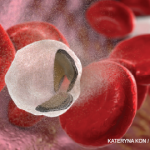Regarding platelet goals, Dr. Streiff counseled, “Remember that for immune thrombocytopenia, the goal is not to normalize the platelet count, but to get it in the 50–100,000/μL range to relieve symptoms and prevent low platelets from causing problems.”
Antiphospholipid Syndrome
Dr. Streiff then turned to APS, the most common primary coagulation disorder seen in SLE. “Thirty to 40% of SLE patients have antiphospholipid antibodies, and 20% of these have clinical significance,” Dr. Streiff explained. Clinical manifestations may include venous and arterial thromboembolism, obstetric complications, livedo reticularis, hemolytic anemia, valvular disease, microvascular disease (e.g., skin, renal, cardiac or pulmonary) and thrombocytopenia.3
As most of us know, the laboratory diagnosis of APS can prove challenging. “It’s important to remember that sample acquisition technique is of utmost importance when testing for APS, and obtaining a variety of tests, preferably off anticoagulation, is important,” Dr. Streiff said. “I recommend checking dilute Russell viper venom time (dRVVT) and activated partial thromboplastin time (aPTT) with a mixing study and confirmation step, as well as cardiolipin and beta-2-glycoprotein I antibodies—especially the IgG isotype. Of note, the presence of isolated anti-cardiolipin antibody and anti-beta-2-glycoprotein I IgA antibody is of unknown clinical significance, and the value of anti-phosphatidylserine antibody and anti-prothombin antibody testing remains unclear.”
What about refractory cases?4 “For recurrent thrombosis, my first step is confirming that the patient had a therapeutic international normalized ratio (INR) during the event and assessing for other risk factors like a vascular catheter,” Dr. Streiff said. “Next, I ensure correlation between the INR and chromogenic factor X (CFX) activity to confirm there isn’t a lupus anticoagulant causing the INR to be overestimated since this occurs in up to 20% of cases. Then I consider a higher INR target if necessary.”
Dr. Streiff took care to remind the audience of the importance of adjuncts to antithrombotic therapy: hydroxychloroquine and statins. Hydroxychloroquine has anti-inflammatory and anti-aggregatory properties that have been shown to reduce thrombosis and decrease titers of cardiolipin and anti-beta-2 glycoprotein I antibodies.5,6 “Hydroxychloroquine use is recommended, unless contraindicated [e.g., for patients with a drug allergy or confirmed retinal toxicity]. Recent studies also demonstrated that statins reduce the risk of venous thromboembolism and may also be considered,” he said.7
Dr. Streiff stressed that direct oral anticoagulants (DOACs) should still not be used in APS because studies to date have shown that recurrent thromboembolism risk is higher with DOACs than with warfarin.8 “The populations in these studies were high risk, but until [DOACs are] proven safe, I continue to recommend warfarin as the go-to drug for APS patients,” he said.

